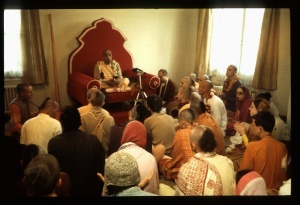CC Madhya 20.218 (1975): Difference between revisions
(Vanibot #0027: CCMirror - Mirror CC's 1996 edition to form a basis for 1975) |
(Vanibot #0020: VersionCompareLinker - added a link to the Version Compare feature) |
||
| Line 2: | Line 2: | ||
<div style="float:left">'''[[Sri Caitanya-caritamrta (1975)|Śrī Caitanya-caritāmṛta (1975)]] - [[CC Madhya (1975)|Madhya-līlā]] - [[CC Madhya 20 (1975)|Chapter 20: Lord Śrī Caitanya Mahāprabhu Instructs Sanātana Gosvāmī in the Science of the Absolute Truth]]'''</div> | <div style="float:left">'''[[Sri Caitanya-caritamrta (1975)|Śrī Caitanya-caritāmṛta (1975)]] - [[CC Madhya (1975)|Madhya-līlā]] - [[CC Madhya 20 (1975)|Chapter 20: Lord Śrī Caitanya Mahāprabhu Instructs Sanātana Gosvāmī in the Science of the Absolute Truth]]'''</div> | ||
<div style="float:right">[[File:Go-previous.png|link=CC Madhya 20.217 (1975)|Madhya-līlā 20.217]] '''[[CC Madhya 20.217 (1975)|Madhya-līlā 20.217]] - [[CC Madhya 20.219 (1975)|Madhya-līlā 20.219]]''' [[File:Go-next.png|link=CC Madhya 20.219 (1975)|Madhya-līlā 20.219]]</div> | <div style="float:right">[[File:Go-previous.png|link=CC Madhya 20.217 (1975)|Madhya-līlā 20.217]] '''[[CC Madhya 20.217 (1975)|Madhya-līlā 20.217]] - [[CC Madhya 20.219 (1975)|Madhya-līlā 20.219]]''' [[File:Go-next.png|link=CC Madhya 20.219 (1975)|Madhya-līlā 20.219]]</div> | ||
{{CompareVersions|CC|Madhya 20.218|CC 1975|CC 1996}} | |||
{{RandomImage}} | {{RandomImage}} | ||
==== TEXT 218 ==== | ==== TEXT 218 ==== | ||
<div class="verse"> | <div class="verse"> | ||
:ei-mata brahmāṇḍa-madhye sabāra | :ei-mata brahmāṇḍa-madhye sabāra 'parakāśa' | ||
:sapta-dvīpe nava-khaṇḍe yāṅhāra vilāsa | :sapta-dvīpe nava-khaṇḍe yāṅhāra vilāsa | ||
</div> | </div> | ||
| Line 25: | Line 24: | ||
<div class="translation"> | <div class="translation"> | ||
"Within the universe the Lord is situated in different spiritual manifestations. These are situated on seven islands in nine sections. Thus Their pastimes are going on. | |||
</div> | </div> | ||
| Line 34: | Line 33: | ||
The seven islands are mentioned in the Siddhānta-śiromaṇi: | The seven islands are mentioned in the Siddhānta-śiromaṇi: | ||
:bhūmer ardhaṁ | :bhūmer ardhaṁ kṣīra-sindhor udaka-sthaṁ | ||
:jambu-dvīpaṁ prāhur ācārya-varyāḥ | :jambu-dvīpaṁ prāhur ācārya-varyāḥ | ||
:ardhe | :ardhe 'nyasmin dvīpa-ṣaṭkasya yāmye | ||
:kṣāra-kṣīrādy-ambudhīnāṁ niveśaḥ | :kṣāra-kṣīrādy-ambudhīnāṁ niveśaḥ | ||
:śākaṁ tataḥ | |||
:krauñcaṁ ca | :śākaṁ tataḥ śālmala-matra kauśaṁ | ||
:krauñcaṁ ca go-medaka-puṣkare ca | |||
:dvayor dvayor antaram ekam ekaṁ | :dvayor dvayor antaram ekam ekaṁ | ||
:samudrayor dvīpam udāharanti | :samudrayor dvīpam udāharanti | ||
The seven islands (dvīpas) are known as (1) Jambu, (2) Śāka, (3) Śālmalī, (4) Kuśa, (5) Krauñca, (6) Gomeda, or Plakṣa, and (7) Puṣkara. The planets are called | The seven islands (dvīpas) are known as (1) Jambu, (2) Śāka, (3) Śālmalī, (4) Kuśa, (5) Krauñca, (6) Gomeda, or Plakṣa, and (7) Puṣkara. The planets are called dvīpa. Outer space is like an ocean of air. just as there are islands in the watery ocean, these planets in the ocean of space are called dvīpas, or islands in outer space. There are nine khaṇḍas, known as (1) Bhārata, (2) Kinnara, (3) Hari, (4) Kuru, (5) Hiraṇmaya, (6) Ramyaka, (7) Ilāvṛta, (8) Bhadrāśva and (9) Ketumāla. These are different parts of the Jambūdvīpa. A valley between two mountains is called a khaṇḍa or varṣa. | ||
</div> | </div> | ||
Latest revision as of 12:56, 27 January 2020

A.C. Bhaktivedanta Swami Prabhupada
TEXT 218
- ei-mata brahmāṇḍa-madhye sabāra 'parakāśa'
- sapta-dvīpe nava-khaṇḍe yāṅhāra vilāsa
SYNONYMS
ei-mata—in this way; brahmāṇḍa-madhye—within this universe; sabāra—of all of Them; parakāśa—manifestations; sapta-dvīpe—on seven islands; nava-khaṇḍe—in different sections, nine in number; yāṅhāra vilāsa—the pastimes of whom.
TRANSLATION
"Within the universe the Lord is situated in different spiritual manifestations. These are situated on seven islands in nine sections. Thus Their pastimes are going on.
PURPORT
The seven islands are mentioned in the Siddhānta-śiromaṇi:
- bhūmer ardhaṁ kṣīra-sindhor udaka-sthaṁ
- jambu-dvīpaṁ prāhur ācārya-varyāḥ
- ardhe 'nyasmin dvīpa-ṣaṭkasya yāmye
- kṣāra-kṣīrādy-ambudhīnāṁ niveśaḥ
- śākaṁ tataḥ śālmala-matra kauśaṁ
- krauñcaṁ ca go-medaka-puṣkare ca
- dvayor dvayor antaram ekam ekaṁ
- samudrayor dvīpam udāharanti
The seven islands (dvīpas) are known as (1) Jambu, (2) Śāka, (3) Śālmalī, (4) Kuśa, (5) Krauñca, (6) Gomeda, or Plakṣa, and (7) Puṣkara. The planets are called dvīpa. Outer space is like an ocean of air. just as there are islands in the watery ocean, these planets in the ocean of space are called dvīpas, or islands in outer space. There are nine khaṇḍas, known as (1) Bhārata, (2) Kinnara, (3) Hari, (4) Kuru, (5) Hiraṇmaya, (6) Ramyaka, (7) Ilāvṛta, (8) Bhadrāśva and (9) Ketumāla. These are different parts of the Jambūdvīpa. A valley between two mountains is called a khaṇḍa or varṣa.